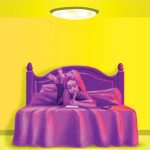Krita has good drawing tools, but stability issues are annoying
This is the second part of a three-part series reviewing free drawing and painting software. I decided to profile these programs to help art students learning from home find an alternative way to create, since they may not have access to school studios and supplies. Last week I profiled SketchBook from Autodesk. It’s a full-featured, very capable and intuitive program that I highly recommend.
This week, I took Krita for a test ride. The software comes from KDE, an international community dedicated to creating free and open-sourced software. Since it’s open source, anyone with the right programming knowledge can modify it. The theory behind open source is that many hands make light work. By allowing any talented, and hopefully altruistic, programmer to work on the product, it will be better and can be offered at no cost. And while open-source programs can be innovative and useful, they may lack the quality control you get from an established company. This appears to be the case with Krita.
The user interface of the program will look familiar to anyone who uses Photoshop. Though similar in appearance, they are very different programs. Photoshop started as photo editing software but was adopted by artists as a drawing, painting and design tool. Over the years, it has evolved to improve its image creation capabilities and expanded to include 3-D and animation functionality, while still maintaining its photo editing functions. Krita is focused mainly on creating images. It doesn’t attempt to offer all that Photoshop has, although it does have animation tools.
What I liked best about the program was its brushes. It has a large selection of drawing tools that mimic traditional media. If you have any familiarity with digital drawing programs, you can start drawing in Krita right away. The predefined brushes offer enough variety that most people won’t need to edit them, although you can if you want.
This is where the learning curve gets a little steeper. I found that trying to use the more advanced features of the program is not as intuitive as SketchBook. I don’t consider Photoshop to be an especially intuitive interface either, but I have been using it so long that I can usually figure things out. With Krita I had to look things up because I couldn’t easily figure them out.
Krita does have the basics common to most drawing programs, and they are not hard to find or figure out. The brush palette is very visible and easily accessible. The color picker uses the common design of a color wheel surrounding a triangle of tints and shades of whatever hue you pick. The toolbox is full of familiar options, such as the eyedropper, magnifying glass, fill bucket, gradient, bezier curves, selection tools and more. You can work with layers and there’s a type tool.
The program has a lot to offer for free. Unfortunately, it currently doesn’t work on iPads or many other stand-alone tablets, but it should be fine on any desktop. You’ll get the most out of the program if you have a tablet you can hook up to your desktop. I found the program to be too glitchy for my taste. It crashed several times while I was using it, and sometimes tools would not respond right away. SketchBook was a much smoother and pleasant drawing experience.

Kevin OʼNeill has been a staff artist for The Times-Tribune since June 1993. In addition to doing illustrations and infographics and designing pages for the paper’s print and electronic publications, he writes InSites, a weekly column about websites and apps. Contact: koneill@timesshamrock.com; 570-348-9100 x5212




